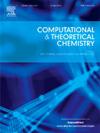Sequential bond energies, electrostatic interactions, structures and end-on σ-donation in H+∙N21−3 clusters: Theoretical study
IF 3
3区 化学
Q3 CHEMISTRY, PHYSICAL
引用次数: 0
Abstract
The structures and binding energies have been determined and examined at the level of the MP2/aug-cc-pVTZ method of calculations. These data indicate that a linear configuration is obtained for the mono- and di-ligated complexes, whereas a tee-shaped structure is determined for the complex. The binding energy in these complexes increases with the number of N2 ligands in the complex. The sequential bond dissociation energy was found to follow the trend: . This trend is in good agreement with the variation detected in the ion⋅⋅⋅quadrupole interaction. Our results show that these complexes are an example of covalently end-on-bonded N2 adducts with H+ ions.

H+∙N21−3簇序键能、静电相互作用、结构和端上σ-给能的理论研究
在MP2/aug-cc-pVTZ计算方法的水平上确定并检验了其结构和结合能。这些数据表明,单配位和双配位配合物具有线性结构,而H+∙n23配合物具有三字形结构。这些配合物的结合能随着配合物中N2配体的数量而增加。顺序键解离能依次为:H+∙N2>;H+∙N22>H+∙N23。这一趋势与离子⋅⋅⋅四极相互作用中检测到的变化很好地吻合。我们的结果表明,这些配合物是一个共价端对键的N2加合物与H+离子的例子。
本文章由计算机程序翻译,如有差异,请以英文原文为准。
求助全文
约1分钟内获得全文
求助全文
来源期刊

Computational and Theoretical Chemistry
CHEMISTRY, PHYSICAL-
CiteScore
4.20
自引率
10.70%
发文量
331
审稿时长
31 days
期刊介绍:
Computational and Theoretical Chemistry publishes high quality, original reports of significance in computational and theoretical chemistry including those that deal with problems of structure, properties, energetics, weak interactions, reaction mechanisms, catalysis, and reaction rates involving atoms, molecules, clusters, surfaces, and bulk matter.
 求助内容:
求助内容: 应助结果提醒方式:
应助结果提醒方式:


